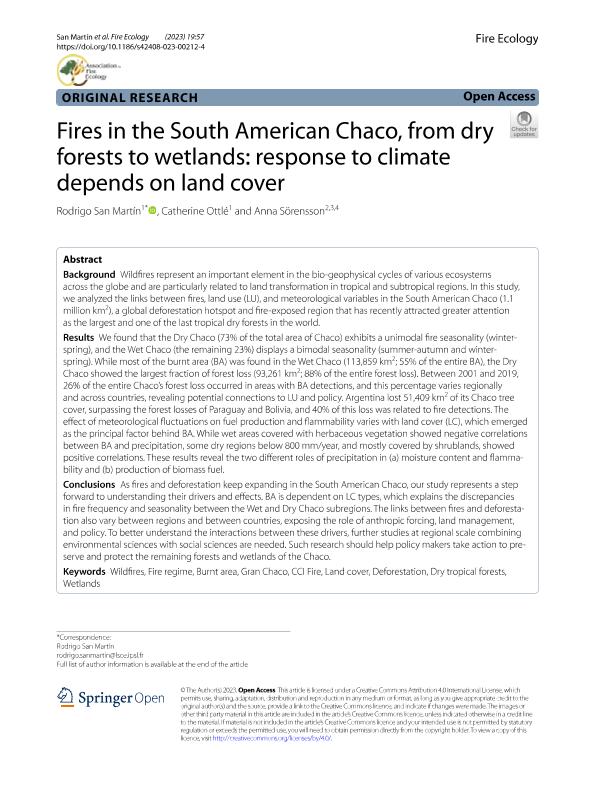Artículo
Fires in the South American Chaco, from dry forests to wetlands: response to climate depends on land cover
Fecha de publicación:
12/2023
Editorial:
Springer
Revista:
Fire Ecology
ISSN:
1933-9747
Idioma:
Inglés
Tipo de recurso:
Artículo publicado
Clasificación temática:
Resumen
Background: Wildfires represent an important element in the bio-geophysical cycles of various ecosystems across the globe and are particularly related to land transformation in tropical and subtropical regions. In this study, we analyzed the links between fires, land use (LU), and meteorological variables in the South American Chaco (1.1 million km2), a global deforestation hotspot and fire-exposed region that has recently attracted greater attention as the largest and one of the last tropical dry forests in the world. Results: We found that the Dry Chaco (73% of the total area of Chaco) exhibits a unimodal fire seasonality (winter-spring), and the Wet Chaco (the remaining 23%) displays a bimodal seasonality (summer-autumn and winter-spring). While most of the burnt area (BA) was found in the Wet Chaco (113,859 km2; 55% of the entire BA), the Dry Chaco showed the largest fraction of forest loss (93,261 km2; 88% of the entire forest loss). Between 2001 and 2019, 26% of the entire Chaco’s forest loss occurred in areas with BA detections, and this percentage varies regionally and across countries, revealing potential connections to LU and policy. Argentina lost 51,409 km2 of its Chaco tree cover, surpassing the forest losses of Paraguay and Bolivia, and 40% of this loss was related to fire detections. The effect of meteorological fluctuations on fuel production and flammability varies with land cover (LC), which emerged as the principal factor behind BA. While wet areas covered with herbaceous vegetation showed negative correlations between BA and precipitation, some dry regions below 800 mm/year, and mostly covered by shrublands, showed positive correlations. These results reveal the two different roles of precipitation in (a) moisture content and flammability and (b) production of biomass fuel. Conclusions: As fires and deforestation keep expanding in the South American Chaco, our study represents a step forward to understanding their drivers and effects. BA is dependent on LC types, which explains the discrepancies in fire frequency and seasonality between the Wet and Dry Chaco subregions. The links between fires and deforestation also vary between regions and between countries, exposing the role of anthropic forcing, land management, and policy. To better understand the interactions between these drivers, further studies at regional scale combining environmental sciences with social sciences are needed. Such research should help policy makers take action to preserve and protect the remaining forests and wetlands of the Chaco.
Archivos asociados
Licencia
Identificadores
Colecciones
Articulos(CIMA)
Articulos de CENTRO DE INVESTIGACIONES DEL MAR Y LA ATMOSFERA
Articulos de CENTRO DE INVESTIGACIONES DEL MAR Y LA ATMOSFERA
Citación
San Martín, Rodrigo; Ottlé, Catherine; Sörensson, Anna; Fires in the South American Chaco, from dry forests to wetlands: response to climate depends on land cover; Springer; Fire Ecology; 19; 1; 12-2023; 1-20
Compartir
Altmétricas




